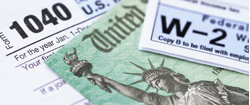The information in this article is up to date for tax year 2024 (returns filed in 2025).
Starting out as a new waiter or waitress can be exciting, but one question that’s bound to come up is, “Are tips taxable?” It’s not always clear, and figuring out how to handle your tips when tax season rolls around can be confusing. Don’t worry though—we’ve got you covered! In this guide, we’ll walk you through everything you need to know about reporting tips, so you can stay on top of your taxes and keep your finances in check.
Key Takeaways
- All tips, including cash and noncash, are taxable and must be reported as income to the IRS.
- Employees must report tips exceeding $20 per month to their employer by the 10th day of the following month to stay compliant.
- Not reporting tips can lead to severe penalties, including fines and increased audit risk from the IRS.
Tip Income and Taxes
Tip income includes any additional payment received by service workers, such as cash, credit card tips, and tips via electronic means. Both cash and noncash tips, including gift cards or tickets, are subject to federal income tax. Employee tip income is also included in this category.
The IRS treats tips as taxable income, similar to your regular wages. Tip income affects your total taxable income and can potentially increase your federal income tax liability.
Every dollar of tip income matters and will be elaborated on in the following sections.
What Counts as Tip Income?
Tip income includes more than just cash tips received directly. It also encompasses tips added to credit card payments and those received through digital platforms. Even noncash tips like gift cards or tickets are taxable and must be reported, as mandated by the IRS.
All forms of tip income contribute to your gross income, affecting your adjusted gross income (AGI) and federal income tax liability. Whether received in cash, through tip splitting, or as noncash items, tips must be accurately reported.
Employees in tipped occupations may not realize the full extent of what constitutes tip income. Regardless of the amount or source, all tips must be reported on your tax return.
Why Tips Are Taxable Income
Tips are taxable because the IRS treats them like any other income. All tips, regardless of amount, must be reported as they are part of your compensation and contribute to your overall earnings.
You must report every dollar of tip income to the IRS, regardless of the amount. Although it may seem tedious, this ensures you pay the correct federal income tax. Failure to report can result in significant penalties and interest charges.
The Role of Federal Income Taxes
Tip income is part of your gross income, which is the basis for calculating federal income taxes. As gross income increases with reported tips, your taxable income rises, potentially increasing your federal tax liability. Tipped income is an important consideration in this calculation.
The IRS also imposes an Additional Medicare Tax of 0.9% on tip income, affecting both your federal and Medicare taxes. Service charges added by employers are also subject to federal income taxes and must be reported.
Understanding these details ensures you are fully prepared to handle your tax obligations.
Reporting Tips to Your Employer
Accurately reporting your tips to your employer is a legal obligation. Employees must report all tips received, whether directly or through a tip pool, to ensure accurate record-keeping and compliance.
Accurate tip reporting helps employers fulfill their tax obligations. Employees must maintain daily records and report monthly to stay compliant with IRS regulations.
Employee’s Daily Record
Maintaining a daily record of tips is crucial for accurate reporting. The IRS recommends using Form 4070A to log daily tips systematically, including those from customers’ bills and tip splitting.
Training programs should emphasize best practices for maintaining daily records to avoid discrepancies. Proper record-keeping aids in accurate reporting and protects employees during audits or disputes.
Monthly Reporting Requirements
Employees must report total tips to their employer if they exceed $20 within a month. This must be done by the 10th day of the following month.
Meeting monthly reporting requirements is essential for both employees and employers to remain compliant with tax laws.
Handling Noncash Tips
Noncash tips, such as gifts or perks, must be included in taxable income. Employees must report noncash tips to their employer. Failure to do so can result in a 50% penalty on unpaid Social Security and Medicare taxes.
All tips, including noncash, are subject to tax and must be reported to avoid penalties. Even gifts received as tips must be accounted for to ensure compliance with tax regulations.
Reporting Tips on Your Tax Return
Including all tips in your gross income on your tax return is crucial. Both cash and noncash tips contribute to your total taxable income and must be reported.
Accurate tip reporting ensures you pay the correct federal income taxes and avoids IRS issues. Employees must calculate and declare tips correctly on their tax returns.
Using Form 4137
To report unreported tip income, fill out Form 4137. This form calculates additional Social Security and Medicare taxes owed, ensuring you meet all tax obligations.
Tips below $20 per month don’t need to be reported to your employer but must be declared as taxable income on your tax return. Using Form 4137 ensures compliance and avoids penalties for unreported tips.
Including Tips on Form 1040
Report tips alongside wages on Form 1040 or 1040-SR, specifically on line 1. This includes all cash and noncash tips, which must be reported on your tax return.
Maintain detailed records of noncash tips for accurate reporting. Tips allocated by your employer should also be reported on Form 1040 to ensure all tip income is accounted for. File with ezTaxReturn and let us complete the forms for you—100% accuracy guaranteed!
Impact on Adjusted Gross Income
Tip income directly increases your adjusted gross income (AGI). Higher AGI can affect eligibility for certain tax credits and restrict access to tax benefits, highlighting the importance of understanding your tips’ impact on your overall tax situation.
Understanding how tip income affects your AGI helps you plan for tax season and ensures you’re prepared to meet your tax obligations.
Employer Responsibilities for Tip Reporting
Employers are key to accurate tip reporting. They cannot keep any portion of employees’ tips and must withhold taxes on total wages, including reported tip income.
Clear policies should outline the consequences of inaccurate tip reporting, ensuring compliance and helping employees meet their tax reporting responsibilities.
Withholding Taxes on Tips
Employers must withhold the correct amount of taxes on tips. No income tax is withheld on allocated tips, nor are Social Security and Medicare taxes deducted. Allocated tips are amounts assigned if total reported tips are less than 8% of gross sales.
Large food or beverage establishments must file Form 8027 if total tips are less than 8% of gross sales. This ensures all tip income is accounted for and taxes are withheld correctly.
Allocated Tips and Form 8027
Allocated tips are assigned when total tips reported by employees fall below a specified threshold relative to gross sales. Employers must use Form 8027 to report these tips, ensuring they are properly documented and taxed.
Form 8027 helps employers accurately report employees’ tip income. Allocated tips should be included on Form 1040 and identified in Box 8 of the W-2, ensuring transparency and compliance with tax laws.
Service Charges vs. Tips
Distinguishing between service charges and tips is important for tax purposes. Service charges are mandatory fees and not considered tips, allowing employers to retain a portion. Auto-gratuities and other employer-added service charges do not need to be reported as tips.
Understanding this difference is crucial for proper tax compliance for both employees and employers.
Common Myths About Tip Reporting
Common myths about tip reporting can lead to misunderstandings and non-compliance. One myth is that small amounts of tip income don’t need to be reported, but all tip income must be accurately recorded to avoid penalties.
Another myth is that only cash tips are taxable. The IRS requires all forms of tips, including noncash, to be reported as taxable income. Understanding these misconceptions ensures proper compliance with tax regulations.
Myth: Small Amounts Don’t Need Reporting
Some employees believe that small tip amounts are exempt from reporting. However, all tip income must be reported to the IRS, regardless of amount. Accurate documentation is crucial, as audit consequences often change reporting habits.
Ongoing training sessions keep employees informed about their reporting responsibilities, reducing misunderstandings and ensuring compliance.
Myth: Tips Under $20 Per Month Are Tax-Free
Another myth is that tips under $20 per month are tax-free. While these tips do not need to be reported to employers, they are still considered taxable income. Even if tips are less than $20 in a month, they remain subject to taxation and must be declared on your tax return.
Understanding this helps ensure that all tip income is accurately reported and taxed, avoiding any potential penalties for underreporting.
Myth: Only Cash Tips Are Taxable
Some employees believe that only cash tips are taxable, but this is incorrect. Tips can be given in cash or as noncash items like goods or services. The IRS requires all forms of tips, including cash and noncash, to be reported as taxable income.
Reporting all tip income, regardless of its form, is crucial for compliance with federal income tax laws and avoiding any penalties for underreporting tip reporting responsibilities.
Consequences of Not Reporting Tips
Failing to report tip income can lead to significant consequences. Underreporting tip income can result in severe penalties and interest charges from the IRS. A prevalent misconception is that all tips are untaxed income, which leads to underreporting by employees.
Not reporting tips increases the likelihood of being flagged for an IRS audit, particularly for service industry employees. The IRS is particularly vigilant regarding tip reporting discrepancies, which can trigger audits and lead to substantial back taxes and penalties.
Penalties for Unreported Tips
The penalties for not reporting tip income can be severe. Failure to declare the income can lead to a fine of up to 50% of the unpaid social security and Medicare taxes. Tax fraud penalties for not reporting tips can reach up to 75% of the underpayment.
Taxpayers may also face an audit and substantial back taxes if tips are not reported correctly. Effective training should cover the importance of accurate tip reporting and the potential consequences of failing to do so.
Increased Audit Risk
Failing to report tips increases the likelihood of an IRS audit due to perceived negligence or potential tax fraud. A low declaration of tip income raises the chances of being selected for an audit by the IRS.
Undeclared tips have serious consequences, possibly being classified as negligence or tax fraud. Post-audit reviews may expose unreported income, leading to significant financial consequences for the employee.
Summary
In summary, understanding and accurately reporting tip income is crucial for both employees and employers in tipped occupations. From maintaining daily records to properly using Form 4137 and Form 1040, every step plays a vital role in compliance with federal tax laws. By staying informed and diligent, you can avoid penalties, reduce audit risks, and ensure that your tax obligations are met. Remember, every dollar of tip income counts, so report it accurately and stay on the right side of the IRS.
Frequently Asked Questions
Are noncash tips like gift cards taxable?
Yep, noncash tips like gift cards are taxable, so you’ll need to report them. It’s good to keep that in mind when you receive one!
Do I need to report tips under $20 per month to my employer?
You don’t need to report tips under $20 per month to your employer, but remember to declare them as taxable income when you file your taxes. Keep it honest!
What form should I use to report unreported tip income?
You should use Form 4137 to report unreported tip income and figure out any extra taxes for Social Security and Medicare. It’s a straightforward way to stay on top of your tax game!
How do tips affect my adjusted gross income (AGI)?
Tips you report will increase your AGI, which might impact your eligibility for some tax credits and benefits. Just keep that in mind when you’re filing!
What is the difference between service charges and tips?
Service charges are automatic fees added by the business, while tips are what you choose to give based on your experience. So, don’t confuse the two; one is required and the other is optional!
The articles and content published on this blog are provided for informational purposes only. The information presented is not intended to be, and should not be taken as, legal, financial, or professional advice. Readers are advised to seek appropriate professional guidance and conduct their own due diligence before making any decisions based on the information provided.




